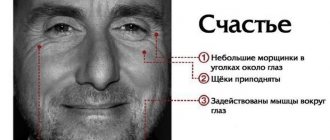21.08.2018
Are human facial expressions universal? Do the facial expressions of foreigners differ, does the culture of a particular nation influence facial expressions, or do we all react the same way with our facial muscles to the same stimuli? What are the main types of facial expressions, and what is the difference between them? What is more believable: our statements or our emotions captured in facial reactions? This article will try to answer all these questions.
Confusion
When confused, a person usually wrinkles his forehead and nose
, sometimes raises one eyebrow up. The lips are usually tightly closed, although greater emphasis still falls on the eyes and nose.
The origin of this facial expression has much in common with similar expressions in our closest relatives, chimpanzees. Confusion represents a lack of understanding
, and the facial expression itself indicates that the person wants to understand something.
When chimpanzees, especially young chimpanzees, experience something new for the first time, they have a look of confusion or surprise on their faces that is remarkably similar to that of a human.
. Both humans and apes have a desire to understand the world around them, albeit at different levels.
Humans and chimpanzees: comparing us and monkeys
When we are shocked by new ideas, problems or new experiences, our facial expressions change just like those of our distant ancestors
, as well as our modern ape relatives.
Just such a face: how the brain creates emotions and why you can’t trust facial expressions
Even though people tend to smile when they're happy or frown when they're upset, facial expressions in and of themselves don't mean anything, says neuroscientist Lisa Feldman Barrett. She spoke in an interview with The Verge about why it is impossible to determine emotions by looking at a face, how we learn to be sad, and what happens to feelings for which there are no words to express them in our language. “Theories and Practices” translated it into Russian.
Lisa Feldman Barrett
neuroscientist at Northeastern University in Boston, author of the book “How Emotions Are Made”
- You prove that emotions are created by our brain. How does this idea differ from the idea that has existed until now?
— According to classical ideas, emotions happen
. Something happens, the neurons react, and a typical expression appears on your face that you cannot control. According to this view, we frown when we're angry and pout when we're upset, and it is believed that people around the world not only have the same set of expressions, but are also born with the ability to automatically recognize them.
From my point of view, when it comes to emotions, facial expressions by themselves don't say anything. However, I am not saying that when a strong feeling is created in the brain, there are no physical indicators of the strength of this feeling. People actually smile when they are happy and frown when they are sad. But what I'm saying is that there is no single mandatory
facial expressions. And emotions are not something objective, they are learned, they are constructed by our brain.
— You write how, during research, you show a person a face in a photograph and ask them to identify an emotion from it, and people invariably make mistakes, for example, they confuse fear and anxiety. But fear and anxiety seem to be close enough feelings. Do people confuse emotions that are truly far apart, such as happiness and guilt?
— It’s interesting that you say that guilt and happiness are far from each other. I often show people the top half of a photo of my daughter's face and they say she looks sad or guilty or despondent, and then I show them the whole photo and her face is actually flushed with pleasure because she's in a chocolate museum.
If you compare a face to anything else, it will always lose. If in one case you show only the face, and in another pair it with a voice, pose or description of the situation, it becomes clear that facial expressions in themselves are difficult to interpret. In some experiments, participants were shown their entire faces but their bodies were completely hidden. The people depicted expressed negative or positive emotions, and the subjects, without context, made mistakes all the time. If you take a super positive face and place it in a negative situation, its expression will be perceived as more negative. Moreover, people do not simply interpret
facial expression as negative, but they also look at it differently, which can be recorded using software that tracks eye movements.
Facial expressions that are considered “correct” are simply stereotypes. People express their feelings in many different ways.
— What about such a phenomenon as resting bitch face syndrome? It's a much-debated topic, with people often believing that this way they can accurately determine who is a bitch and who is not, but women dispute such claims and say that they "just have that face."
“We've researched this, and the 'bitchy' face is actually just a neutral expression. If you look closely, there is nothing hostile about him. People use context or their knowledge of that person to see more negativity in their face.
“I’m wondering what all these findings mean for emotional programming or startups that are trying to analyze your facial expressions to understand how you feel?” Does this mean it is useless?
“The way they are doing this now will lead many companies to failure. If people rely on the classical view when developing their designs - if you are trying to create software or technology to identify frowns, furrowed brows or pouting lips and so on and conclude that such facial expressions indicate anger, then good luck.
But if emotional programming and other technologies in this field adjust their goals a little, then they have the opportunity to revolutionize the science of emotions. We need to learn how to accurately track human movements, and it would be so useful to measure them and capture as much internal and external context as possible.
- So, we know that emotions do not have a universal form. Can you explain your argument that emotions are created? As I understand it, what you are saying is that we have a basic feeling (like “pleasant” or “unpleasant”) and physical sensations that are at times triggered by the environment. We then interpret these feelings as specific emotions, like rage or guilt. How it works?
— The brain evolved to regulate the functioning of the body. The brain has to decide where to invest its resources: what will I spend and what reward will I receive? Our brain constantly regulates and constantly predicts what our body will feel in order to decide how much energy to expend. When these sensations are very strong, we tend to use emotional concepts to make sense of the incoming sensory information. We create emotions.
- Let's go back a little. What are emotional concepts?
- This is what you know about emotion; you can't necessarily describe it in words
, but your brain knows what to do with it, and you know the feelings that come from that knowledge. When you drive a car, your brain knows how to do certain things automatically, and you don't have to formulate them or even be aware of the action in order to drive successfully.
When you know an emotional concept, you experience that emotion. For example, in our culture there is “sadness”, in the Tahitian culture there is none. Instead, they have a word whose closest translation is “the kind of tiredness you get when you have the flu.” This is not the equivalent of sadness, it is what they feel in cases where we would be sad.
- How do we learn these concepts?
“First we learn concepts from our parents. You don't need to teach children feelings
. Babies can suffer, they can and do experience pleasure, they can be excited or calm. But emotional concepts—such as feeling sad when something bad happens—are taught to children, although not always overtly. And this process does not end in childhood. The brain is able to connect past experiences in new ways to create new ideas, to experience something new that we have never seen, heard or felt.
— I am fascinated by the connection between language and emotions. From your point of view, if we don't have a word for an emotion, then we can't experience it?
— Here’s an example: you’ve most likely experienced “Schadenfreude” (“joy at other people’s failures,” schadenfreude; the concept came to English from German. — Ed.)
And yet you didn't know the word, but your brain had to work hard to create these concepts and turn them into emotions. It took you a long time to describe your feelings.
And if you know the word, if you hear it often, then it happens automatically, just like driving a car. This feeling is easier to trigger and easier for you to experience. This is exactly the story of the Americans and Schadenfreude: they have a word that they use often. This feeling can be recalled very quickly.
— Does understanding that they are constructed help us control emotions?
— Controlling your emotions will never be an easy task, and you will never be able to change the way you feel with the snap of your fingers.
But learning new words to describe emotions is useful because it helps you understand the nuances of emotions and better regulate them. For example, you can learn to distinguish between suffering and discomfort. This is partly why mindfulness meditation is so helpful for people who have chronic pain: it helps separate physical discomfort from suffering.
I think understanding how emotions are created expands the boundaries of control. You understand that if the brain uses your past to create your present, you must invest energy in the present to receive new experiences that will then become the seeds of your future. You can cultivate impressions now, and then, if you encounter something similar, they will become so automatic that your brain will reproduce them on its own.
Shame
The facial expression when a person is ashamed of something is recognizable all over the world. It involves downcast eyes with an expression of sadness or worry
. The head and corners of the lips are usually also lowered down. Sometimes a person covers his face with his hands. The expression of shame is very similar to the expression of submission.
In a group of primates, once someone assumes a dominant position, the rest of the group becomes subordinate, their eyes and heads downward, signaling the end of the conflict.
Secrets, shame and guilt
In our complex society, failure is usually divided into personal and competitive. For example, we may be defeated (and feel shame) in a game, or if our hopes are not met,
or if we do not live up to what other people expect of us.
All this can be expressed in completely different ways, but the feeling of shame is always present when we admit defeat
.
Astonishment
The expression of surprise is easy to recognize by the wide open eyes and mouth. The feeling of surprise or shock is close to the feeling of fear. Surprise is one of our most instinctive emotions
, which is reflected in facial expressions. Most of the time, our facial expression changes unconsciously, but when we are surprised, the reaction on our face can appear instantly.
All primates, as well as many other animals, roll their eyes
when experiencing fear or anxiety.
10 Little-Known But Important Human Senses
If something unexpected happens to us, our eyes open wide and our pupils enlarge so that we can better orient ourselves in space.
, and also respond faster.
Concentration
The facial expression when a person focuses on something usually depends on the situation. If he concentrates on a specific task, his eyes look straight and motionless
. On the other hand, if a person is focused on some thought, his eyes may be raised up or his gaze directed to the side. It often happens that a person stops blinking.
Interestingly, with a fairly fixed gaze, a person’s tongue can dangle from side to side.
or move nervously in some other way. Most of us do this completely unconsciously. With this phenomenon, the brain's energy is focused on the task and does not control the movements of the rest of the body.
Practical advice
They will help fight apathy every day.
- Change the melody on your alarm clock to a more pleasant one, perhaps to your favorite song. Do this as often as possible.
- Diversify your diet, fill the menu with your favorite food, include chocolate, bananas, ice cream.
- If you want to buy something, buy it, be it clothes or headphones. Shopping will bring joy.
- Think about hobbies and favorite activities. Perhaps you have long wanted to finish reading a book, but never found the time, or you constantly put off going to billiards.
- Go in for sports - even banal exercise helps cope with drowsiness.
- Try to listen to more positive music and watch comedies, even if it seems that you are not in the mood for this.
- Start rearranging and improving your personal space.
- Record your successes and achievements. Even just making a list of everyday activities and checking the boxes next to them will show you that you are achieving something every day. And it doesn’t matter that the list won’t include conquering the world, but taking out the trash and washing the dishes.
Fatigue
An obvious sign that a person is feeling tired and fatigued is half-open eyelids
. The eyebrows are often raised upward in an attempt not to close the eyes. Fatigue is caused by exertion without sufficient rest.
In primates, especially the more intelligent apes, facial expressions of fatigue are similar to those in humans. When primates are preparing to enter into conflict, or are already involved in conflict, they evaluate their chances of success by how the enemy carries himself, as well as closely studying his energy level
. The expression of fatigue on his face means that the other party will be less afraid.
Human primate abilities
The person also shows their physical energy level
by facial expression. In the same way, other people will evaluate our abilities at the moment.
Seduction
The art of seduction or temptation is often regarded as one person trying to force another to engage in some behavior.
, usually with sexual overtones. Facial expressions during seduction can be completely different, but there are several features that are easy to recognize.
Usually the seducer looks intently at the other person, his eyes may be slightly narrowed. The lips are usually tightly compressed or slightly parted. The head can be tilted to the side, showing an open neck.
Staring usually attracts the other party's attention. A certain position of the lips and an open neck look attractive and sensual. If such a facial expression is accompanied by frequent blinking and a slight smile
, then the seduction effect is achieved.
Anger
Expressing anger, more than any other emotion, is common to people of all cultures and nations. The appearance of a person in anger and his behavior are unmistakably guessed
: the eyebrows frown, the eyelids tense, the head is usually slightly lowered down, the gaze is from under the brows.
Anger is associated with unpleasant, annoying and disappointing situations. This is a very primitive feeling that is common to many species of animals.
. Our expressions of anger are similar to those of other primates, and the facial expressions are incredibly similar.
Expressing anger extends your life by 2 years
Facial tension is usually combined with body language, which allows other people to better understand our emotions
. As social creatures, we have the ability to influence the mood of other people.
If a person experiences anger in a company, he unmistakably stands out from the crowd, and the rest begin to feel tense
. The facial expression that shows tension and irritation coincides with what the person is experiencing inside himself.
Apathy in psychology
It is not difficult for a professional psychologist to determine that a person is depressed. To better understand what an apathetic person means, it is worth considering the signs of manifestation of these personality traits.
The first sign may be a loss of interest in past hobbies. A person reduces his contacts, communicates less with loved ones, stops showing interest in various events, and stops participating in them. Does not show emotions where before he would have been angry or happy. His behavior changes: he speaks without expressing emotions, begins to alienate himself from society, most often ignores the questions that are asked to him, and if he answers, it is only superficially.
An apathetic person does not empathize, he is not at all interested in the problems and grief of others, he does not rejoice in the successes of loved ones. Sometimes he even begins to push away his relatives in a state of apathy due to the lack of emotional reactions. It is important to note that the more attention is paid to such a person, the more actively he tries to distance himself from the world. There is a tendency to spend time aimlessly and inactively. All actions occur, rather, by inertia, without much participation. Autonomic reactions also disappear, that is, the person no longer blushes or turns pale, and spontaneous gestures disappear. A lethargic state can also provoke a person to give up personal hygiene.
Fear
When a person experiences a feeling of fear, his eyes open wide and his eyebrows rise high on his forehead. The mouth usually also opens wide. Fear, like surprise, is closely related to instincts
and indicates a desire to avoid something.
One scientific study that took place in 2008
, was dedicated to the facial expressions of a person who experiences fear.
The results showed that people who feel fear inhale more air
and are able to complete tasks much faster due to the fact that their eyes are wide open.
Thus, facial expression enhances sensory perception
.
Man's greatest fears
Showing a feeling of fear on your face turns out to be quite a practical behavior that helps a person avoid dangerous situations.
, enhancing his feelings.
Sadness
The expression of sadness on the face is usually easily recognized by the downturned corners of the lips and eyebrows
. Sadness is usually associated with feelings of loss and helplessness. The expression of sadness on the face often appears in people who withdraw into themselves.
The origin of this facial expression is quite simple: a person’s emotions seem to weaken, he droops, thus his facial features also fall down. Sadness can also be an indication of defeat
, a feeling of reluctance to communicate with others.
Do you feel sad and despondent? Food may be to blame!
Too bright faces as a sign of pathology
Endocrine disorders often externally manifest themselves as polar signs: on the one hand, an unhealthy shine in the eyes, swiftness in the gaze, and on the other, a sleepy, even lazy expression on the face, pallor and puffiness.
A hormonal disorder called Cushing's syndrome is characterized by a ruddy, round face with a sagging chin, small eyes, a small mouth with downward curved lips, and sometimes even a mustache.
A round face, practically no hair on it, small wrinkles and an infantile look are a sign of male hypogonadism. Such patients are called people without age.
Tetanus manifests itself externally in spasms of the facial muscles, which makes the person look constantly smiling.
Joy
The expression of joy is the most universal facial expression.
. The facial expressions of a person experiencing a feeling of happiness are the same among people of all cultures. This expression is accompanied by a smile and crescent-shaped eyes, even babies show similar facial expressions when they feel joy.
Scientists and evolutionary experts offer various explanations for the origins of expressions of joy that are associated with smiling. Unlike various other expressions, a human smile has a different meaning than the "smile" or baring of teeth of great apes
who use it to intimidate.
Secrets of a smile: new details
Many researchers agree that the human smile is in some way derived from this primate expression. By showing off our teeth, we demonstrate the state of our health.
. Today, a person no longer uses a smile to intimidate, but to show others that everything is fine with us.
In difficult social situations, smiling usually helps to win over other people.
. If a person smiles sincerely, others are more drawn to him.
How to overcome apathy due to depression
If the apathetic state has developed against the background of depression, then it will not be possible to cope with it using standard simple methods. The result may not appear for a very long time, and in some cases a person will not be able to cope with this condition without professional help from specialists.
The main thing is to understand the root cause of this condition and eliminate it. In a state of apathy, this will not be so easy to do. This requires serious self-analysis, recognition of mistakes and wrong actions. If you feel that you cannot cope on your own, it is better to consult a psychologist or psychotherapist.










